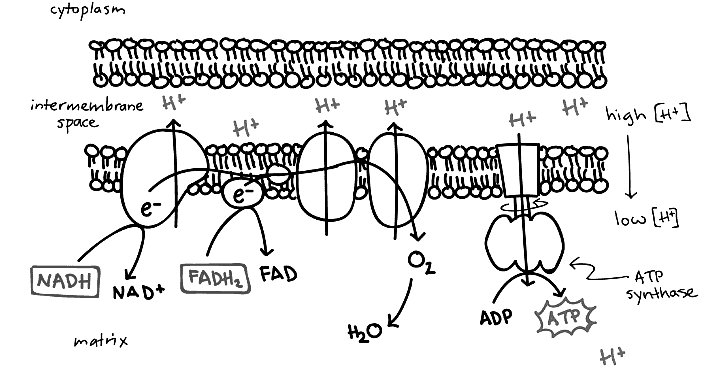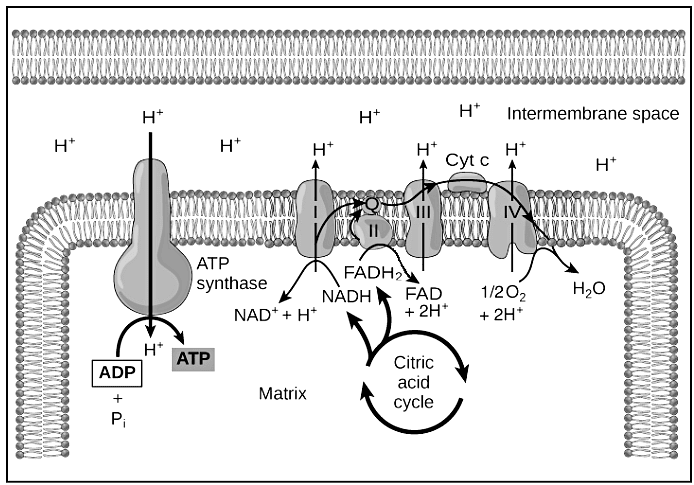Oxidative Phosphorylation | Zoology Optional Notes for UPSC PDF Download
| Table of contents |

|
| The Vital Role of Oxygen in Cellular Respiration |

|
| Oxidative Phosphorylation: A Cellular Powerhouse |

|
| Electron Transport Chain |

|
| Chemiosmosis |

|
| ATP Yield in Cellular Respiration |

|
The Vital Role of Oxygen in Cellular Respiration
Oxygen is not just a component of the air we breathe; it plays a critical role in the energy production processes within our cells. The intricate dance of cellular respiration unfolds, and oxygen takes center stage for a crucial performance.
Oxidative Phosphorylation: Unveiling the Cellular Energetic Finale
Oxidative phosphorylation marks the grand finale of cellular respiration, comprised of two essential acts: the electron transport chain and chemiosmosis.
1. Electron Transport Chain (ETC): Passing the Baton of Electrons
In the ETC, electrons elegantly pass from one molecule to another, releasing energy with each transfer. This energy doesn't go to waste; instead, it orchestrates the formation of an electrochemical gradient.
2. Chemiosmosis: Transforming Gradients into ATP Harmony
Here, in the second act, the stored energy in the electrochemical gradient is harnessed to craft adenosine triphosphate (ATP), the cellular currency of energy.
Oxygen's Pivotal Role: The Electron Transport Chain Finale
Enter oxygen, the star of the show. Oxygen positions itself at the grand finale of the electron transport chain. Here's where the magic happens:
- Electron Acceptor: Oxygen graciously accepts electrons, creating a symphony of electron transfer.
- Proton Pickup: Simultaneously, oxygen picks up protons, crafting a molecular masterpiece – water.
Oxygen's Absence: A Disruptive Intermission
What if oxygen takes a back seat? Picture a scenario where oxygen is scarce, like when someone isn't breathing in enough. The consequences are profound:
- ETC Standstill: Without oxygen, the electron transport chain grinds to a halt.
- ATP Production Ceases: The consequence? The cessation of ATP production through chemiosmosis.
- Cellular Dysfunction: ATP is the lifeblood of cellular activities. Without it, essential cellular reactions stumble, and, over time, cells may face dysfunction or even demise.
The Symphony of Cellular Respiration: Oxygen's Standing Ovation
In essence, oxygen's role in cellular respiration is a standing ovation-worthy performance. It ensures the smooth progression of the electron transport chain, sustains the production of ATP, and, ultimately, keeps the cellular symphony in harmony. The breaths we take not only fill our lungs but also fuel the cellular orchestration of life.
Oxidative Phosphorylation: A Cellular Powerhouse
At the heart of cellular respiration lies a powerhouse – oxidative phosphorylation. This dynamic process orchestrates a symphony of electron movements, proton gradients, and ATP synthesis. Let's take a journey through the key steps of this remarkable biochemical ballet.
1. The Electron Transport Chain (ETC): A Molecular Relay
- Location: Embedded within the inner mitochondrial membrane, the ETC is a series of proteins poised to receive the baton – electrons.
- Entrance of Electrons: NADH and FADH₂, crafted in earlier stages of cellular respiration, deliver their electrons to the ETC. NADH contributes at the first complex, while FADH₂ enters at the second.
- Proton Pumping: Electrons gracefully move "downhill" through the ETC, triggering an elegant dance of proton pumping. The first, third, and fourth complexes shuttle protons from the matrix into the intermembrane space.
2. Oxygen's Grand Finale: Water Formation
Final Act: The electrons, having traversed the ETC, reach their dramatic conclusion with oxygen. Oxygen graciously accepts electrons and protons, a theatrical moment that gives rise to water – a harmonious conclusion to the electron transport spectacle.

3. Proton Gradient: Setting the Stage for Chemiosmosis
The ETC's proton-pumping extravaganza creates a protons-in-the-intermembrane-space party. This sets the stage for chemiosmosis, the second act of oxidative phosphorylation.
4. ATP Synthase: The Energy Converter
Enzymatic Water Wheel: Protons, eager to return to the matrix, flow through ATP synthase – the enzymatic water wheel. This flow powers ATP synthase to spin, converting the energy into a currency cells can use – ATP.
5. ATP Synthesis: The Cellular Payoff
As protons joyfully cascade back into the matrix, ATP synthase spins, catalyzing the conversion of adenosine diphosphate (ADP) to adenosine triphosphate (ATP). This ATP, now charged with energy, becomes the cell's primary fuel.
In summary, oxidative phosphorylation is a captivating narrative of electron travels, proton dances, and ATP synthesis. From the electron transport chain's relay of electrons to oxygen's watery encore, and the chemiosmotic dance of protons through ATP synthase, this process powers the cellular stage, ensuring the harmonious vitality of life.
Electron Transport Chain
In the intricate dance of cellular respiration, the Electron Transport Chain (ETC) takes center stage, orchestrating a sequence of steps that culminate in the production of ATP. Let's delve into the captivating performance of the ETC:

1. Ensemble of Membrane-Embedded Artists
Location: Embedded within the inner mitochondrial membrane (or the plasma membrane in prokaryotes), the ETC comprises proteins and organic molecules, organized into four significant complexes labeled I to IV.
2. Electron Elevation and Proton Pumping Ballet
- Electron Journey: NADH and FADH₂, crafted in preceding stages of cellular respiration, contribute their electrons to the ETC. NADH, adept at donating electrons, takes the spotlight at complex I, initiating a series of redox reactions. As electrons pirouette through the chain, energy is released and used to pump protons into the intermembrane space.
- FADH₂'s Unique Dance: FADH₂, with electrons at a lower energy level, takes a distinct route through complex II, avoiding proton pumping. This 'bypass' leads to fewer protons being pumped, highlighting FADH₂'s unique contribution.
3. Unified Electron Path: Ubiquinone and Cytochrome C Duets
- Electron Convergence: Both complex I and complex II converge at ubiquinone (Q), a mobile electron carrier. Reduced to form QH₂, ubiquinone traverses the membrane, delivering electrons to complex III. Here, more protons join the dance as electrons continue their journey.
- Cytochrome C Waltz: Electrons are handed off to cytochrome C (cyt C), another mobile carrier, which gracefully transports them to complex IV. This final act sees a surge of pumped protons as electrons prepare for their grand finale.
4. Oxygen's Grand Finale: Water Waltz
Oxygen's Ballet: At complex IV, electrons embark on their final leg, meeting oxygen. Oxygen accepts electrons and protons, forming water – the breathtaking conclusion to the electron transport spectacle.
5. Cellular Harmony: Functions of the ETC
- Regeneration of Electron Carriers: NADH and FADH₂ relinquish their electrons, reverting to NAD⁺ and FAD, essential for sustaining glycolysis and the citric acid cycle.
- Proton Gradient Creation: A proton gradient emerges across the inner mitochondrial membrane, akin to storing energy. This gradient sets the stage for the upcoming ATP production through chemiosmosis.
- The Electron Transport Chain, with its elegant choreography of electrons and protons, is a vital player in cellular respiration's grand performance. Its dual roles of regenerating electron carriers and creating a proton gradient pave the way for the synthesis of ATP, the cellular currency of energy.
 |
Download the notes
Oxidative Phosphorylation
|
Download as PDF |
Chemiosmosis
In the captivating finale of cellular respiration, chemiosmosis takes the stage, transforming the energy stored in a proton gradient into the rhythmic beats of ATP synthesis. Let's unravel this energetic dance:
1. Proton Pumps and the Electrochemical Ballet
- Proton Pumping: Complexes I, III, and IV, enchanted with the energy of electrons cascading energetically downhill, channel this vigor into pumping H⁺ ions from the matrix to the intermembrane space. This creates an electrochemical gradient, akin to a stored battery of energy.
- Proton-Motive Force: This gradient, sometimes called the proton-motive force, forms a reservoir of energy. Protons, like many ions, can't traverse the hydrophobic core of the membrane independently. They rely on channel proteins, and in the inner mitochondrial membrane, ATP synthase is the sole conductor.
2. ATP Synthase: The Turbine of Cellular Power Plants
- Conceptual Turbine: ATP synthase, a membrane-spanning protein, conceptually mirrors a turbine in a hydroelectric power plant. Instead of water turning it, ATP synthase is set in motion by the flow of H⁺ ions down their electrochemical gradient.
- Catalyzing ATP Synthesis: As ATP synthase twirls, it acts as a catalyst for the addition of a phosphate to ADP, capturing the energy from the proton gradient and converting it into ATP. This enchanting transformation completes the cellular symphony.
3. Chemiosmosis Beyond Cellular Respiration
Ubiquitous Process: Chemiosmosis extends beyond cellular respiration, also playing a pivotal role in the light reactions of photosynthesis. It stands as a versatile process where energy from a proton gradient is harnessed to perform work.

4. Heat Release: A Thermal Interlude
Waste or Warmth: In some cells, the energy stored in the proton gradient isn't solely dedicated to ATP synthesis. Specialized cells, like brown fat cells in hibernating mammals, harbor uncoupling proteins. These proteins, acting as channels, provide an alternative route for protons to flow back into the matrix without engaging ATP synthase. This deliberate 'uncoupling' allows the dissipation of energy as heat, a strategic move for animals needing warmth during hibernation.
In the grand finale of cellular respiration, chemiosmosis orchestrates the transformation of a proton gradient into the harmonious melody of ATP synthesis. Beyond cellular respiration, this versatile process resonates in photosynthesis and showcases its adaptive prowess in heat generation.
ATP Yield in Cellular Respiration
Embarking on the energetic journey of cellular respiration, one may wonder, "How much ATP is the cellular treasury enriched with after the breakdown of glucose?" While precise figures might waltz to a slightly different tune in various books, the consensus revolves around a range of 30-32 ATP per glucose molecule.
1. ATP Ballet: A Choreography of Pathways- Glycolysis: The performance commences in glycolysis, where two net ATP are crafted.
- Citric Acid Cycle: Continuing the spectacle, an additional two ATP (or GTP) grace the stage in the citric acid cycle.
Note on Precision: The precise number in this ensemble, especially concerning the ATP yield from glycolytic NADH, wears a veil of uncertainty due to glycolysis transpiring in the cytosol. The transport of NADH electrons to complex I in the inner mitochondrial membrane involves a molecular "shuttle system."
2. Oxidative Phosphorylation: The Grand FinaleNADH Yield: As electrons sway through the electron transport chain, each NADH orchestrates the pumping of about 10 H⁺ ions, culminating in the synthesis of approximately 2.5 ATP.
FADH₂ Yield: FADH₂, stepping into the chain at a later stage, orchestrates the pumping of 6 H⁺ ions, yielding around 1.5 ATP.
NADH Shuttle: Some cellular ensembles boast a shuttle system directing electrons to the transport chain via NADH, yielding 5 ATP for two glycolytic NADH.
FADH₂ Shuttle: Alternatively, in other cellular compositions, a FADH₂ shuttle orchestrates a duet, producing only 3 ATP from the two glycolytic NADH.
The final act in this energetic drama involves a reckoning. While 30-32 ATP may be a crescendo in the symphony of glucose breakdown, it's a high-end estimate. The cellular respiration stage serves as a nexus, where intermediates may be spirited away for other metabolic pathways, tempering the final count.
As the cellular currency dances through glycolysis, the citric acid cycle, and oxidative phosphorylation, the real yield emerges as a dynamic interplay, a fluctuating count in the grand symphony of cellular respiration.
|
181 videos|346 docs
|






















